Filling the Gap: AMOLED and LCD from 2010 to 2012
by Joshua Ho on July 26, 2014 6:00 AM ESTHTC Rezound
The Rezound is one of the last devices that hit the market before devices regularly saw color accuracy testing and closer evaluation of grayscale performance. Subjectively, this display is still great even today. While the Rezound’s display is supposedly S-LCD (implying *VA), the viewing angles are much better than what was seen on the Desire HD. The one issue here is that the display isn’t laminated to the glass lens, so at extreme angles the display quality isn’t as good as what we see on S-LCD2 or S-LCD3 from phones like the HTC One X. At any rate, it’s very obvious that HTC has put a large emphasis on display with this device.
While luminance is dramatically improved over the Desire HD, I suspect that brightness was clamped to some extent again to alleviate battery life issues. Contrast isn’t great here either, at 733:1. As before, there’s no dynamic contrast active here to try and artificially boost contrast. Modern LCD displays have around 1000:1 typical contrast, so this is just a bit worse, all things considered.
HTC definitely didn’t do a perfect job in grayscale once again, as there’s still too much blue and green, but white point is at a reasonable level compared to the wildly unbalanced white points that we saw with the Galaxy S2. Things are also significantly improved here relative to the Desire HD.
In the saturation sweep, HTC did an incredible job calibrating the display. It’s quite clear to me that HTC made display a priority with this device. There’s a hint of saturation compression, but overall things are very close to perfect. This is definitely a leap ahead of AMOLED at the time.
Unfortunately, the Rezound falls a bit flat in the ColorChecker. Poor grayscale calibration definitely didn’t help with the average, although there is significant error elsewhere. Of course, this is from the lens of the present. At the time, it seems that HTC was making a concerted effort to do things right, even though no one was truly paying attention to display accuracy yet and reviewers seemed to be impressed by blue white points and intensely oversaturated colors.
Final Words
Looking through this new information, understanding the past is now much easier in terms of display. While I was only able to test Samsung and HTC devices, they serve as a relatively accurate barometer for trends in the rest of the industry. As the past is an excellent predictor for the future, a few trends are evident. First, AMOLED has had far more progress than LCD, although checkered due to the pressure for higher pixel density displays and relatively little pressure (at first) to improve color accuracy. Second, while LCD has been slower to advance it has also started at a far better place. One of the chief issues seems to have been controlling gamma/grayscale color balance, although this has been steadily improving throughout the industry. Color gamut and saturation sweep accuracy has generally been acceptable in LCD, although there seems to be a bit of a cyclical relationship as consumers favor wildly inaccurate colors for showroom appeal. LCD seems to have stagnated in contrast, with relatively little change in static contrast ratios over the past few years, and brightness seems to be limited to around 600 nits in practice, barring unconventional subpixel layouts.


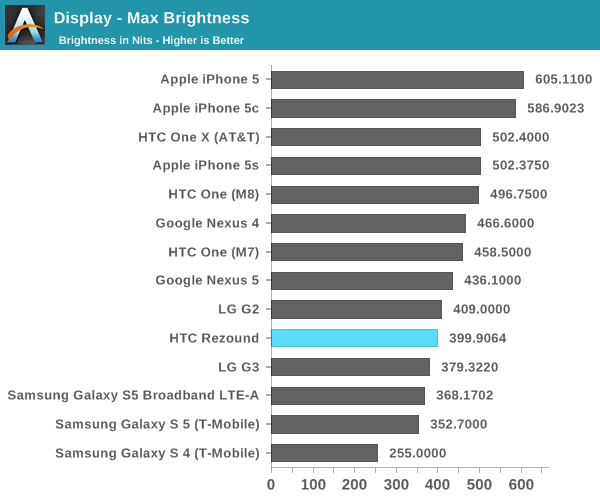
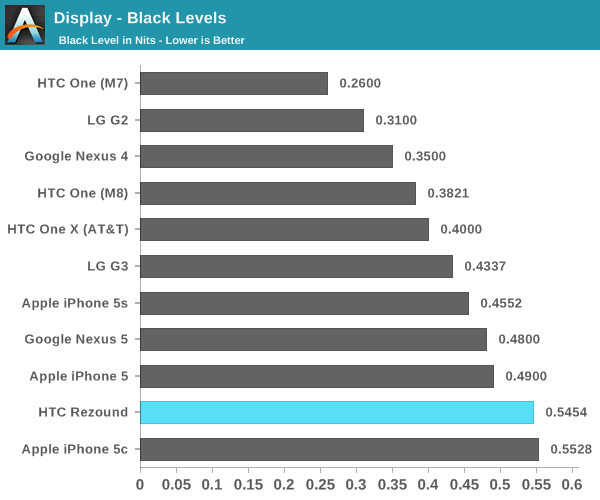
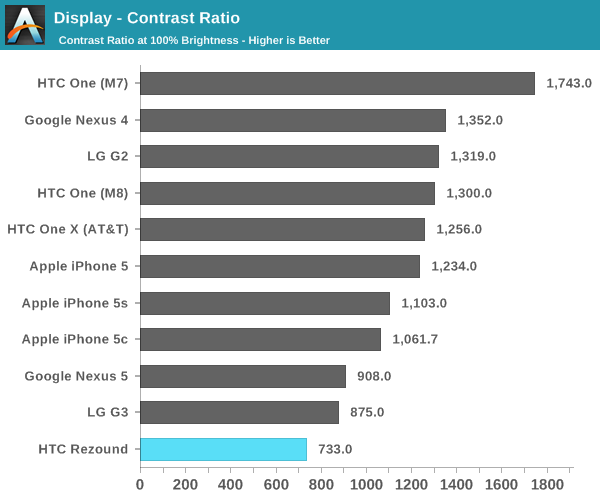
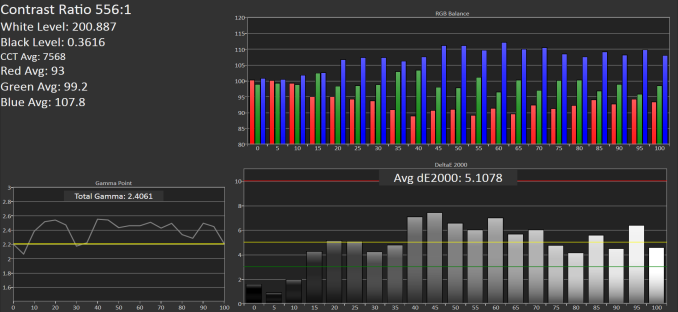
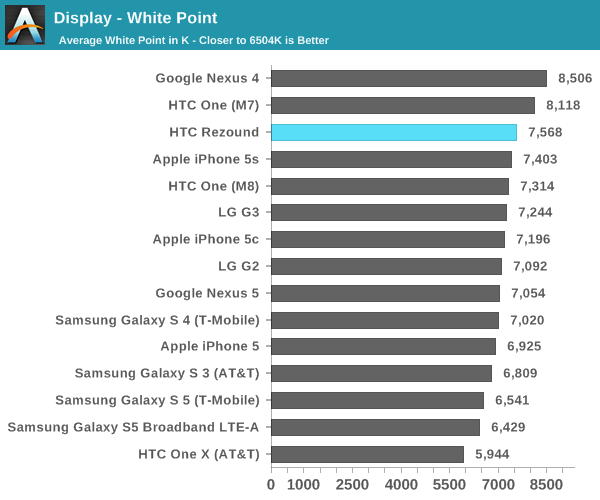

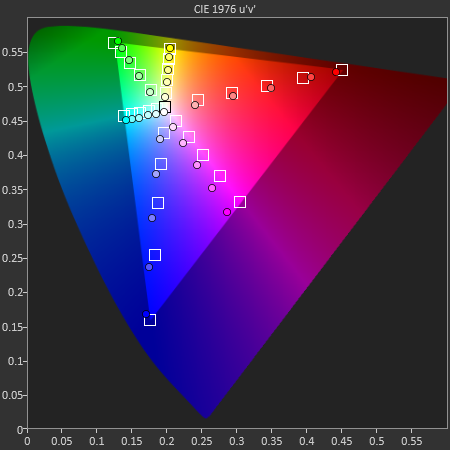
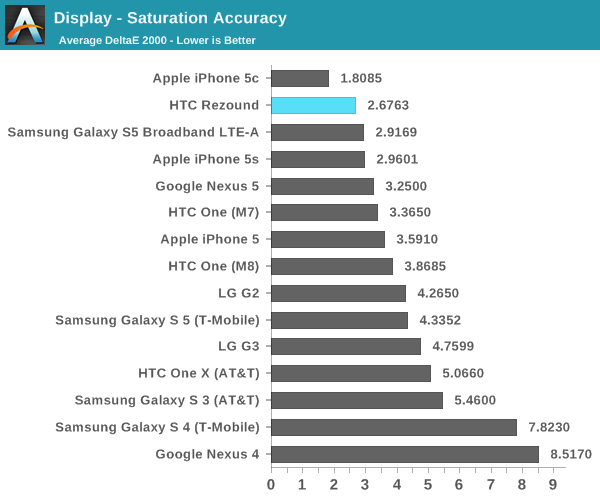

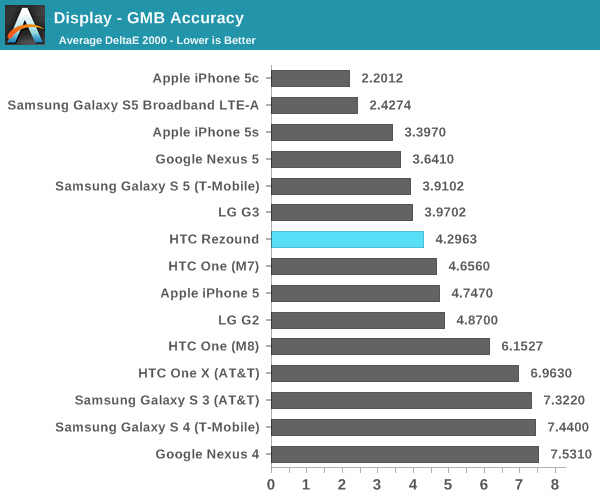








72 Comments
View All Comments
kokono - Monday, July 28, 2014 - link
I still have an Athlon64 X2, system with nForce chipset, still going strong,it would be nice to see some new tests..
Orenj - Saturday, July 26, 2014 - link
Having just retired my Rezound for an Xperia Z1 Compact (another 4.3" 720p--yay for phones that actually fit in your pocket!), I can vouch for the fact that the Rezound had a great display; the z1c, while generally good, is noticeably less accurate in color at brighter settings. Unfortunately, neither is bright enough to be usable outside in the sun here in Tucson... still waiting for fast color e-ink. Oh yeah, and the Rezound had atrocious battery life even when new; the z1c is a dream in comparison.scy1192 - Saturday, July 26, 2014 - link
Upgraded from the Rezound to the LG G3. With all the poo-pooing the display got I was worried it would be worse than my Rezound, but I'm glad that it turned out to be better all-around. It really did have a great display for the time.HangFire - Saturday, July 26, 2014 - link
Thank you for filling in the gaps, and yes some of us do care, maybe I'm just one of the 3.5 that do. Also I never realized HTC released a "Thunderbolt 2" (aka Rezound) wow it's a good thing they gave it more than one name. By November 2011 no one wanted anything to do with anything called Thunderbolt! I recall my original Tbolt had what seemed to be a very nice display, but could not compare to my better half's AMOLED in sunlight. That didn't bother me too much, but the battery life and lack of a modern Android O/S sure did. I wonder how it compares to the Rezound et al, but it's all academic now, at least my M7 rocks!SunLord - Sunday, July 27, 2014 - link
Unless these are basically never used phones wouldn't it be kinda pointless to test the screen on an Amoled display due to how they wear out after a few years?mkozakewich - Sunday, July 27, 2014 - link
Now that they're testing this, they can do an "after three years" test on models like the S3 or iPhone 5.I agree the tests on the older phones don't mean as much, but then, people aren't going out and buying them all that much, either. It's still important historical data about the progress of these technologies.
Icehawk - Sunday, July 27, 2014 - link
What was the point of this in 2014?HangFire - Monday, July 28, 2014 - link
The industry keeps telling us they're getting better, but it isn't always so.AnnonymousCoward - Monday, July 28, 2014 - link
Thanks for doing this review, so I can actually compare my current phone with the latest.Peichen - Tuesday, July 29, 2014 - link
Early Android phones are crap. Poor display, cheap build, laggy and small battery. The only thing keeping it afloat is the huge marketing budget.Android phone from the Spring 2013 cycle on are much better and closer to iPhone in general quality. Screens are on par with iPhone except color calibration. Build quality on some models improved a lot with better parts. Lag still there but mitigated with fast SOC. Battery life are on par except the phone have to be big to accommodate the big battery.